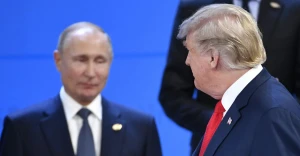
Russian forces retreat 5-15 km from Dnipro bank due to Kakhovka HPP explosion - OC South
Occupying Russian forces retreated 5-15 km from Dnipro after blowing up the Kakhovka hydroelectric power plant (HPP) on June 6
Operational Command South's press center head Natalia Humeniuk said this during the telethon.
“They retreated to different distances, depending on the water spill. They pulled back their positions from 5 to 15 kilometers,” she said.
Despite the flooding in the Kherson region, the Russian troops did not stop shelling the right bank during the evacuation of local population.
“They shelled the areas of Kherson that were flooded. And they shelled the shopping center again, perceiving it as a 'hub' where people could gather for help,” said Humeniuk.
She also noted that despite the withdrawal to other positions, the Russians still have the ability to shell the right bank of the Dnipro River in the Kherson region with artillery.
Explosion of the Kakhovka hydroelectric power station
On June 6, occupying Russian forces blew up the Kakhovka hydroelectric power plant, completely destroying it. The evacuation of residents of the flooded areas began. After that, President of Ukraine Volodymyr Zelenskyy convened an emergency meeting of the Security and Defense Council, and the world began to respond to the tragedy. Follow the detailed course of events here.
In particular, Ukraine's Cabinet of Ministers has allocated UAH 1.5 billion to build two new water mains that will help supply Kryvyi Rih, Nikopol and Marhanets with drinking water. In addition, the Kherson, Mykolaiv, Zaporizhzhia and Dnipro regions were allocated almost UAH 846 million to meet the regions' drinking water needs.
And a number of Ukrainian cities have declared their readiness to accept southerners.
Instead, Lieutenant General Serhiy Nayev, commander of the AFU Joint Forces, said that the occupiers' blowing up of the Kakhovka hydroelectric power plant would not affect the Ukrainian counteroffensive. And the Kyiv HPP is covered from air strikes and protected from enemy subversive reconnaissance groups.
For his part, Ukrhydroenergo CEO Ihor Syrota said that the peak of the water spill from the Kakhovka reservoir is expected in the morning of June 7. According to him, after that the situation will begin to stabilize, and in 4-5 days the water will start to subside.
And the President of Ukraine held a meeting of the supreme military command to discuss the situation at the front, readiness for a counteroffensive, and the Russian explosion of the Kakhovka hydroelectric power plant. He emphasized that Russia had mined the dam of the hydroelectric power plant last year, and Ukraine was ready for the explosion.
In addition, Volodymyr Zelenskyy discussed the consequences of the hydroelectric power plant explosion and the risks to the Zaporizhzhia nuclear power plant with the IAEA Director General and invited him to Ukraine.
The Ministry of Agrarian Policy has estimated that about 10,000 hectares of agricultural land on the right bank will be flooded as a result of the destruction of the Kakhovka HPP.
On the evening of June 6, the UN Security Council met to discuss the situation that arose after Russian troops blew up the Kakhovka hydroelectric power station dam. Ukraine's permanent representative to the UN, Sergiy Kyslytsya, said that by blowing up the hydroelectric power plant, the Russians had proved that they were unable to hold the temporarily occupied territories. In turn, the UN Under-Secretary-General emphasized that the explosion of the hydroelectric power plant would have far-reaching consequences for many thousands of people.
US President Joe Biden also responded to the tragedy. He assured of his support and assistance to Ukraine.



- News









































